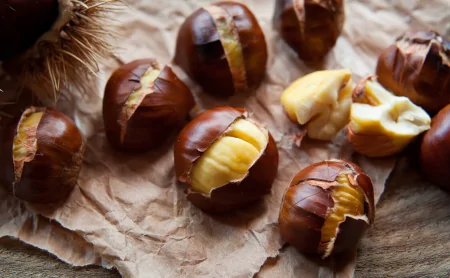Culture
European settlers were quick to plant sweet Chestnut trees in NZ and there is record 1 was planted in New Plymouth's Brooklands Park in 1847. In 1883, Chestnut Knight's Prolific and New Prolific were listed in NZ tree planting guides.
There are 4 main species of Chestnuts and the most common in NZ is Castanea Sativa. The other varieties are C. Crenata, C. Dentata and C. Mollissima.
The NZ Tree Crops Assn has been working away since 1975 cataloguing and breeding chestnuts and have produced several hybrids of the Euro-Japanese varieties. Now, over 95% of all sweet Chestnut commercial plantings in NZ are of these cultivars.
Chestnut trees develop naturally and pruning, other than removing any wind damaged branches, is not necessary. They are very long lived trees and will still be fruiting 100 years from now. Their soil preference is to grow in deep, richly fertile, well drained acidic soils. To produce top quality nuts, they need adequate and consistent watering's over the growing season.
Like many other fruitfully productive trees, Chestnut trees don’t like spots exposed to constant strong cold winds, shade, heavy wet poor draining soils, strong coastal conditions. Chestnut trees flower in early summer, set and develop its nuts over summer for harvest in early autumn (around March). The nuts will fall free of the spiky burrs that encase them.
Enrich the soil with good quality Compost, Blood and Bone & Pumice. Mulch well with Compost after planting to keep its roots cool, moist & undisturbed. Provide plenty of consistent watering's over the growing season and during hot dry spells. Feed with a balanced Fruit Tree fertiliser and Blood & Bone in spring – better still is applications of well rotted chicken manure, blood and bone, and compost in late winter, again early summer. It has been said by a commercial Chestnut Grower the trees respond well to a annual spring dressing of ground seaweed. They are intolerant of lime so do not apply this around them.
Harvested nuts keep well if kept in clean, dry cool conditions. in the fridge they will keep 2-3 weeks.
Roasting the nuts
With a sharp pointed knife, cut into the skin a cross shape at the bottom of the nut. This will stop the nut from exploding when you cook them! After they are roasted ((this can be done in the oven or in a pan on a gas burner) place the hot nuts into a container and seal with a lid. Let the nuts steam in the container for about 5-10minutes. The resulting steam that comes out of the nuts will separate the hard skin from the nut and make peeling much easier. If you are roasting on a gas burner or fire, try making a chestnut pan – which is a frying pan with lots of small holes 10mm drilled into the base. You place the scored chestnuts in the pan and put over the fire. Continually shake the pan to move the nuts around as they cook and are scorched by the flames coming through the holes in the pan.
